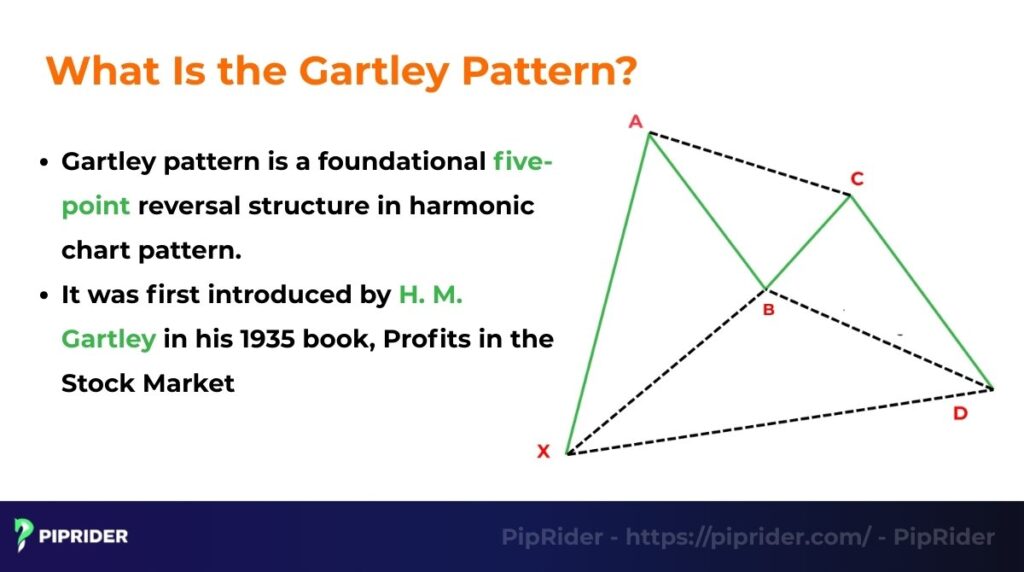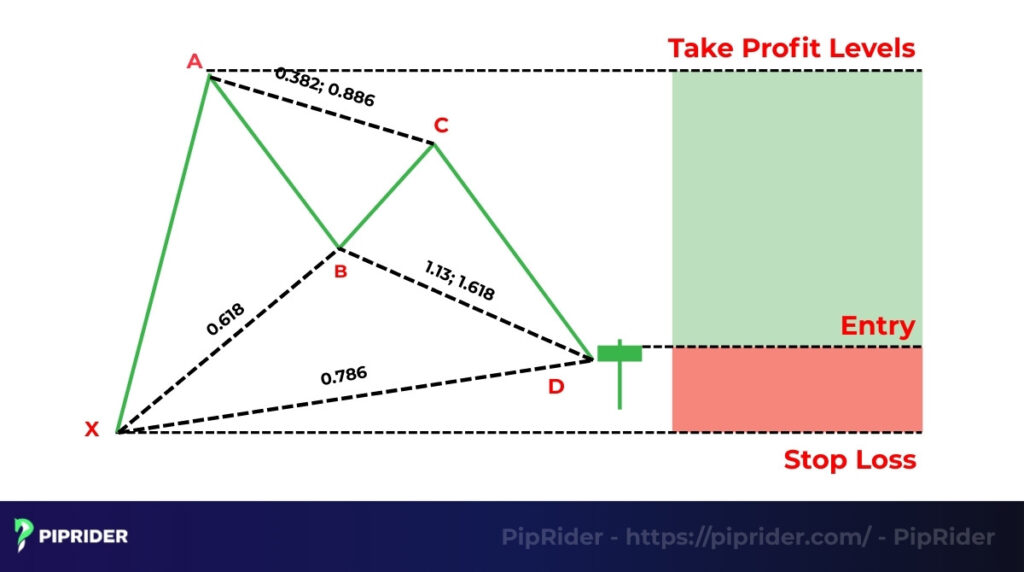Gartley patterns are the well-known formations in harmonic chart pattern trading, offering a structured, rule-based approach to identifying high-probability market reversals. Its reliance on precise geometric structures makes it a powerful tool for identifying high-probability market reversals.
This guide provides a complete playbook on what the pattern is, how to identify it using Fibonacci ratios, and the trading strategy for trading it effectively.
Key Takeaways
- The ABCD pattern is a five-point harmonic structure that signals potential trend reversals, offering clear entry points.
- It has two forms: a bullish (buy signal) and a bearish Gartley pattern(sell signal).
- Identification is based on specific ratios, with the 0.786 retracement marking the key entry zone.
- A clear trading plan involves an entry at the reversal zone (PRZ), a stop loss beyond the X point, and defined price targets.
- Its reliability increases when confirmed with other indicators and proper risk management.
1. What Is the Gartley Pattern?
According to Investopedia, the Gartley pattern is a foundational five-point reversal structure in harmonic chart pattern. It was first introduced by H. M. Gartley in his 1935 book, Profits in the Stock Market, often called the “Gartley 222 pattern”.

Gartley pattern’s reliance on Fibonacci numbers provides a more objective, rule-based approach to trading reversals in technical analysis. These measurements are based on statistical methods that have been observed over decades of market data.
Unlike Cup and Handle or Wedge formations, Gartley’s reliance on specific measurements provides a more objective, rule-based approach to trading reversals in price movements.
2. Understanding Gartley Patterns
The Gartley pattern appears in two mirror-image variations: bullish and bearish. Both signal a potential trend reversal by telling a story of momentum exhaustion.

- The Bullish (M-Shape): The pattern appears at the end of a downtrend and signals a potential buying opportunity. Its “M” shape visually represents sellers failing to push prices to new lows, with the final dip to point D signifying their exhaustion just before buyers are expected to take control.
- The Bearish (W-Shape): This is the opposite, appearing at the end of an uptrend and signaling a potential selling opportunity. Its “W” shape shows buyers failing to push prices to new market highs, with the final rally to point D signifying their exhaustion before sellers take over.
The psychology behind the pattern reflects a failed trend continuation. The pattern begins with a strong impulse (XA), followed by an initial pullback (AB). The market then tries to resume its trend (BC) but fails to reach the prior reaction highs or low, signaling weakness. The final leg (CD) represents a last-ditch effort that fails at a key Fibonacci level, indicating the opposing side is now in control and a reversal is likely. It is a powerful tool for analyzing shifts in market trends.
3. Identifying and Analyzing Gartley Patterns
The power of this pattern lies in its precise geometric structure, defined by specific ratios. Identifying these ratios correctly is paramount to validating the pattern.
3.1. Fibonacci Ratios (0.618, 0.786, 1.272…)
The pattern relies on four main Fibonacci retracements and extensions levels to define its key turning points:
- AB Retracement: The AB leg should retrace exactly 0.618 of the XA leg.
- BC Retracement: The BC leg can retrace either 0.382 or 0.886 of the AB leg.
- CD Retracement: The CD leg can be either a 1.272 or 1.618 extension of the BC leg.
- XD Retracement: Crucially, the final D point (the Potential Reversal Zone or PRZ) must be a 0.786 retracement of the entire XA leg. This 0.786 retracement of XA is a defining characteristic of the pattern.
It is the confluence of these precise ratios, especially the 0.618 at B and the 0.786 at D, that makes the Gartley pattern a high probability reversal signal similar in reliability to formations like the triple bottom pattern.
3.2. The Key Points (X, A, B, C, D)
The pattern is defined by five key pivot points on the chart, labeled X, A, B, C, and D. These points connect to form four distinct price movements or “legs” that create the pattern’s structure.
- XA Leg: The initial impulse leg, representing the primary directional move that sets up the pattern. It is the longest leg.
- AB Leg: The first retracement, where the price moves against the XA leg.
- BC Leg: A smaller move in the direction of the initial trend, but it does not exceed the high (in a bearish pattern) or low (in a bullish pattern) of point A.
- CD Leg: The final and most important leg. It moves against the BC leg and completes at a specific Fibonacci level, forming the D point and the PRZ.
3.3. Gartley Pattern vs. Other Harmonic Patterns
While all harmonic patterns rely on Fibonacci ratios, the key to distinguishing them lies in their specific measurements, particularly the B-point retracement and the D-point completion. Traders can find many ABCD pattern examples as these are foundational harmonic patterns. Understanding the subtle differences on a butterfly pattern chart is key to not confusing it with a Gartley.

| Pattern | Key B-Point Retracement (of XA) | Key D-Point Completion (of XA) |
| Gartley | 0.618 | 0.786 Retracement |
| Bat | 0.382 – 0.50 (Shallower) | 0.886 Retracement (Deeper) |
| Butterfly | 0.786 | 1.272 Extension (D extends beyond X) |
| Crab | 0.382 – 0.618 | 1.618 Extension (D extends far beyond X) |
In sum up,
- Gartley and Bat are retracement patterns, with the final D point located within the range of the initial XA move.
- Butterfly and Crab are extension patterns, with the D point forming beyond the initial X starting point.
4. How to Trade the Gartley Pattern
Trading Gartley pattern requires a disciplined, rule-based approach. The strategy centers on identifying the PRZ and then planning the entry, stop-loss, and profit targets.

4.1. Entry Strategy
The entry for a trade is always taken at the completion of the D point, within the PRZ. However, we strongly recommend waiting for a confirmation signal within this zone rather than entering blindly.
- For a Bullish (Long Entry): Once the price enters the PRZ, wait for a bullish confirmation signal, such as a bullish engulfing candle or a pin bar. A trader would then place a buy order after this signal appears.
- For a Bearish (Short Entry): Once the price enters the PRZ, wait for a bearish confirmation signal, such as a bearish engulfing candle or a shooting star. A trader would then place a sell order after this signal appears.
4.2. Stop-Loss Placement
A non-negotiable rule when trading the Gartley is the correct placement of your stop-loss. This defines your risk and protects capital if the pattern fails.
The most logical stop-loss location is just a few pips beyond the pattern’s X point. Point X marks the origin of the entire structure; a price break past this level invalidates the geometric and Fibonacci relationships, rendering the trade setup unviable.
4.3. Profit Targets
Once your entry and stop-loss are set, the final step is to define your exit strategy for a winning trade. The Gartley pattern offers logical profit targets based on Fibonacci levels.
Profit targets are typically based on the Fibonacci retracement of the move from point A to point D.
- Target 1 (Conservative): The first profit target is the 0.382 Fibonacci retracement of the A-D leg. This is a high-probability target where many traders take partial profits.
- Target 2 (Standard): The second and most common target is the 0.618 Fibonacci retracement of the A-D leg. This level often acts as a significant point of resistance levels or support.
4.4. Indicators to Combine with the Pattern
While a valid Gartley pattern is a strong signal on its own, its reliability increases significantly when confirmed by other technical indicators. This alignment of signals, known as “confluence,” is what we look for in A+ setups.
- RSI (Relative Strength Index): When a bullish completes at point D, check if the RSI is in “oversold” territory (below 30) or showing bullish divergence. This confirms that selling momentum is exhausted and a reversal is likely.
- MACD (Moving Average Convergence Divergence): A bullish crossover of the MACD line and signal line, or a bullish divergence on the MACD histogram, occurring within the PRZ provides strong confirmation of a potential upward move.
- Volume: A classic confirmation is a decrease in volume as the pattern forms, followed by a significant surge in volume as the price reverses out of the PRZ. This shows that conviction is building behind the new move.
Advanced traders may even use Elliott Waves to confirm the context of the larger move.
5. Real-Life Examples
Theory is important, but seeing the pattern on a real chart is the best way to understand its power. Let’s analyze a case study in the forex market.
Case Study: Bullish Gartley in Forex (EUR/USD)
- The Setup: On the EUR/USD 4-hour chart, a potential bullish pattern formed after a clear downtrend. The key X, A, B, and C points were identified, and Fibonacci tools projected the PRZ at the critical 0.786 retracement of the initial XA leg.
- The Trade: As the price entered the PRZ, a bullish engulfing candle appeared, providing the necessary confirmation signal. An entry was taken with a stop-loss placed just below the X point. Profit targets were set at the 0.382 and 0.618 Fibonacci retracements of the move from A to D.
- The Outcome: The price reversed strongly from the PRZ, hitting both profit targets over the following sessions for a successful trade.
6. Advantages and Limitations
Like any technical tool, the Gartley pattern has distinct strengths and weaknesses. Understanding this balance is key to using it effectively.
6.1. Advantages
When identified correctly, the pattern offers traders several distinct advantages:
- High probability of reversal: The pattern’s strict Fibonacci rules help filter out market noise, often identifying potential reversal points with a high degree of accuracy.
- Clear and objective rules: It provides specific, non-subjective levels for entry (point D), stop-loss (point X), and profit targets, which removes guesswork from the trading process.
6.2. Limitations
However, no pattern is perfect, and traders must be aware of the potential drawbacks:
- Potential for false signals: Like all patterns, the Gartley can fail. A false signal can occur if the price continues to trend past the PRZ, especially in highly volatile markets.
Reliance on confirmation: The pattern is most effective when not used in isolation. It often requires confirmation from other indicators (like RSI or MACD) or price action signals to increase its reliability.
7. Frequently Asked Questions (FAQs)
8. The Bottom Line
Gartley patterns are classic harmonic structures that offer a reliable, rule-based framework for identifying potential market reversals.
Its effectiveness is significantly enhanced when combined with trading software for context and other indicators for confirmation. As with any new strategy, we strongly recommend practicing on a demo account before risking real capital.
To continue building your chart analysis expertise, explore our comprehensive Forex Chart Patterns category on Piprider.








